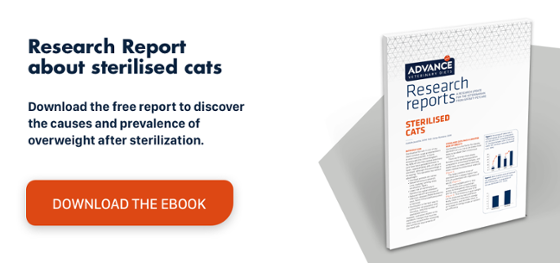Food for sterilised cats: do they have different nutritional needs?
The sterilisation of cats is a routine surgical procedure in small animal clinics, while its advantages make it an important practice for pet health in general. On the other hand, the hormonal changes in sterilised patients come with organic changes that must be treated. The following article outlines the key features for preventing obesity, such as feeding sterilised cats with a dry food.
Sterilisation: facts and falsehoods
“HE HAS BEEN HUNGRIER SINCE HE WAS STERILISED”
Fact: shortly after the procedure, sterilised cats seem unable to control how much they eat. Increased consumption is known to occur immediately after sterilisation, when cats tend to eat everything placed before them.
If preventative steps are not taken, the over-consumption and decline in basal metabolism can lead to significant weight gain.
The extra accumulation of adipose tissue causes direct pathophysiological changes in the cat’s body, which translates into extra strain on various systems, most notably the musculoskeletal system.1
Furthermore, obese cats tend to present a greater risk of developing diabetes, a disease characterised by the patient’s partial or total inability to produce insulin, giving rise to clinical signs ranging from polyuria, polyphagia and polydipsia to pancreatitis, kidney failure or heart failure.
To ensure animal wellbeing, veterinary professionals have the important obligation to increase owner awareness about the potential risks for pets with a high body condition score.
“MY CAT IS FAT BECAUSE HE’S STERILISED, IT’S NOT HIS FAULT”
While it is true that sterilised cats are more prone to gain weight, it is completely avoidable. Interventions as simple as putting out less food or dedicating some time to playing with the cat every week can produce remarkable improvements in terms of controlling the cat’s weight. Another option is to use cat toys that encourage activity to obtain food.
“STERILISATION MAKES CATS LAZIER AND CHANGES THEIR PERSONALITY”
False: Studies show that cats are not necessarily lazier after sterilisation. However, they do undergo some behavioural changes that are desirable in household cats. On one hand, there is a decrease in sexual behaviours, such as territorial urine marking, running away from home, fighting, and so on. On the other, they become much calmer. If physical activity is stimulated through playing, sterilised cats will respond by increasing their activity.
Sterilised cats have lower energy requirements
It has been shown that sterilised cats require less energy, which means that their dietary intake must be reduced to maintain an ideal weight.
- There are two possible explanations for this:
- Decreased metabolic rate
- Decreased physical activity
As mentioned above, we can assume there is a decline in physical activity due to changes in sexual behaviour and adjustment to indoor life. With respect to metabolic rate, there is no consensus and various studies have produced contrasting results. Some researchers reported a decrease of about 30% in resting metabolic rate, while others point towards a change in body composition, which would decrease the cat’s muscle mass, resulting in reduced energy expenditure (54% of energy expenditure is related to muscle mass).
Food for sterilised cats: key points for preventing obesity
The dietary goals for sterilised cats are to reduce weight and maintain a healthy body condition.
Before making any changes to the patient’s routine, calculate the cat’s optimal weight, then use this to establish some short-term goals and the relevant indications for achieving them.
Important factors to bear in mind:
- Restrict energy intake: Recommendations are to restrict energy by 14–40%. The most widely accepted reference values are 50–60 kcal/kg/day, but it has been reported that under 40 kcal/kg/day is still enough.
- Prohibit unrestricted access to food: Sterilised cats cannot control how much they eat.
- More protein, less fat: Improve body composition to lose weight.
- Add indigestible cellulose: This reduces the patient’s energy intake.
- Healthy lifestyle: Ideally, dietary interventions should be accompanied by an increase in physical activity. Playing with cats, encouraging them to move around to find food and environmental enhancement are the best ways of encouraging physical activity.
Special commercial diets for sterilised cats typically include high-quality protein, a reduced fat content, added amino acids, such as L-carnitine, to improve fat metabolism, and satiating substances so that the food is not rejected.
An example of such diets is the ADVANCE STERILIZED range, which contains all the ingredients listed above to ensure cats maintain an ideal body weight without neglecting any essential nutrients, plus it has an optimal pH to reduce the risk of urinary problems. For patients with recurrent urinary stones, ADVANCE has launched a new diet to help control weight while maintaining a healthy urinary tract (ADVANCE Urinary).
Conclusions
A healthy, balanced and complete diet, along with increased physical activity, is essential for controlling the weight and body condition of sterilised cats so that the effects of the surgery do not diminish the animal’s quality of life and health.
If you want to know more about sterilisation, metabolic changes and behavioural alterations in sterilised cats, we recommend reading this report from Affinity Petcare’s R&D department.

